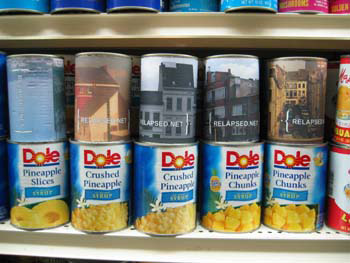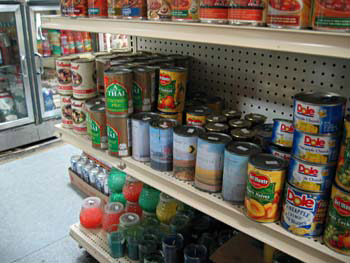Many bloggers have expressed their concerns towards the appearance of advertisements in the RSS landscape. Although it was an inevitable evolution, many have seen it as a violation of this wonderful ex-ad-free tool. So how about podcasting. Imagine listening to someone’s post when all of the sudden there’s a commercial break. Then what?
If you look at the history the internet and its related spin-off products have, you’ll see advertisement is following every technological evolution very closely. Marketers just ‘know’ how to turn a communicative source into a money cow that can be milked until it’s dry. You’ve seen it happen in papers, on the radio, on tv and on the internet.
After the internet and the multimedia surrounding it, we had to wait a bit until the next communication device was launched. Some attempts have been made in between the internet-boom and ‘blogging’, but none were so successful as the public notepad. Everyone has had it with the sites that turned into every search engine’s top twenty that were stuffed with ads only, so marketeers started focussing on the blogs. Just check on blogspot and you’ll pretty soon find blogs that are floating in advertisement, that pull many visitors but only have strictly commercial purposes. So people started avoiding these publicity-blogs.
So yes, there has been a breakthrough – again – in reaching out to possible consumers and in approaching them to communicate in a personal and yet still corporate fashion, where the ads just blend in.
A little while ago ‘Axe’ (the deodobrand) did some wonderful things with characterblogging. A very keened out marketingplan that has proven to be very effective. Instead of offering ads to people, people now request to see the ads. That is a very big u-turn.
In between publicity-blogs and characterblogs came RSS. Where can it fit in? It’s almost a fact that every news provider or blogger has an RSS feed or likewise format by which readers can remotely check what’s new.
It’s a very direct method of communicating, because again users need to subscribe in order to receive the info and by doing so, they express their intrest in the things being told on this blog or newssite. A very good source for marketeers to specifically target potential buyers and send them a message. So what is wrong with advertisement through RSS?
The fact is, the user didn’t request to receive advertisement and that’s why he feels violated. He’s subscribed to a feed and did so while it was ad-free. Therefor he expects it to remain ad-free, unless he has expressed his explicit consent towards the publisher of the feed.
What the RSS user needs to understand is the following :
Perhaps the publisher of the feed has noticed the Click-Through ratings are dropping when everybody remains in their feed reader, where the news is served whilst hot. Perhaps advertisers on this publisher’s site saw that too and decided to advertise less, depriving the publisher of income.
Now the publisher needs to find new means to gather financial support,
and publishing advertisement in a popular RSS feed is one solution to do so. I’ve posted an article about the guidelines of ads in RSS last week.
Some things you could consider too :
If you’re on Pay-Pal and wish to notify people they are allowed to contribute something to keep you working, you could add an item in your RSS feed named ‘Contribute to keep this feed ad-free’ in which you could explain your situation and the importance of donating.
It’s very important to respect existing readers, as a publisher, I can’t stress that enough. Given the ease of unsubscribing, you can’t afford to stuff the feed with ads all of the sudden. That’ll cost you valuable readers. Instead, try to let them participate in the procedure of the transition to a sponsored feed, by polling them first about their
thoughts. It’ll make your users feel more involved and connected too.
Are there limits on this RSS thing for the end user ?
Nathan Weinberg came up with the following hypothesis about the capacity of the RSS readers :
“Imagine for a minute that RSS has replaced all traditional methods of internet information retrieval for you, save search. How many RSS feeds would that total? For an average web surfer, I would suspect about 100. For a power user, 500 (this assumed every single bit of information on the internet were available via RSS).”
[...]
“RSS will hit a wall as the limitations of the clients destroy the content. I hope to god its not the last one, because I’m convinced RSS has the potential to eventually replace the web as we know it. 90% of my web time is spent in RSS.”
About podcasting :
Given the fast evolutionary progress, it’ll only be a matter of time when a podcast transmission is interrupted for a commercial, the same way it has been going on for the radiostations. I believe it’s pretty obvious that a publisher with a few thousand listeners can need the money to pay for his bandwidth or hosting . This is a crucial problem, especially for smalltime broadcasters who’re now stashing the audio-files on their own little hosting accounts. 50 or 100 MB is large for a site, but incredibly petite for an archive of a speech-diary.
Are there limits on podcasting ?
What is the limit of individual and independent podcasts? I say it is the same limit as the server has that hosts a spoken archive. In the end, every user should either join a big hosting company or delete his old archives, and by doing so, he in fact deletes his broadcasting history.
The limits on the other end of the line are the user’s caching possibilities, and the capacity of every one’s HD. More than with any other medium, downloading podcasts every day really fills up the hard disk fast. Stocking problems should be the first limit the end user will experience
In conlusion :
Advertisement will appear everywhere mankind goes. Shortly after the first human will have set foot on Mars, there will be a sign saying :
‘DisneySpaceâ„¢ opening soon’ or a real estate representative that sells
insurance and houses. Because you never know.
RSS takes away traffic from the sites behind the feeds, the loss of visitors and ad-clickers needs to be compensated in order to keep the site and thus the feed alive. There’s little more to say to it.
Podcasting is not so popular ar RSS, but is gaining in popularity as you read. Logical thing to happen is that advertisements will be broadcasted either announced or ad-random while listening to a person speak. It isn’t going to be very different from listening to the radio, I guess. Except that the ads itself could be very more targeted, because of the clearly marked audience.
In his comment-section, Nathan replied to a theory I’ve summoned after his predictions of the future of RSS.
Q : [...] B) There should be something like a ‘pay to receive ad free rss’ or an ‘instant authorize rss’ service, since many newssites require logins and many professional sites are to be paid for.
A : [...] Don’t be surprised if RSS feeds start to cost money. They’re big losers at the moment for publishers, and if they become more popular, they’ll go subscription. If an aggregator company was smart, it could convince all the premium sites to band under a single subscription band, like cable television, and that would be your monthly fee for all the premium RSS content. Then the aggregator makes money, the publisher makes money, and you aren’t paying a lot, but getting a lot. I’d pay for it.
So would I.




